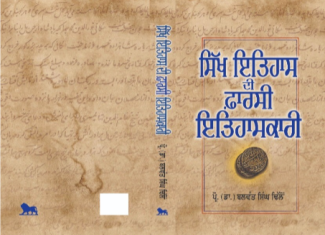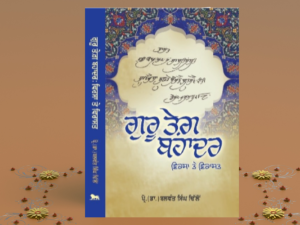Book Title: Persian Historicity of Sikh History (Guru Period 1469-1708): Sikh Itihaas dee Pharsi Itihaaskari (Guru-Kal 1469-1708) (Punjabi version)
Author: Dr Balwant Singh Dhillon, Ex-Director, Centre for Studies on Sri Guru Granth Sahib, Guru Nanak Dev University, Amritsar
Publisher: Singh Brothers, Amritsar. First Edition 2022; pages:305; Price: Rs. 650
Reviewed by: Prof. Hardev Singh Virk, #14017, 30 Ave, Surrey, BC, Canada
The book under review is written in Punjabi and divided into two parts. Part I contains 12 Chapters dealing with Guru-Period of Sikh History (1469-1708). Part II contains 29 Chapters dealing with Persian sources of Sikh history. In my view, the author, Balwant Singh Dhillon, is the first Sikh historian who has utilized a multiplicity of Persian sources on such a vast scale. It is a herculean effort and the author needs our appreciation for this monumental work dealing with the history of Guru-period.
In Introduction, author narrates the story of his encounter with Persian sources of History during 1973-74 when he was doing MA in History at Rajasthan university, Jaipur. In 1977, he got a fellowship from GND university, Amritsar and a chance to explore sources of Sikh history. During 1997-98, he got a chance to examine Persian documents at Rajasthan State Archives in Bikaner. This study resulted in publication of 3 books, one of which, Banda Singh Bahadur: Persian Sources (2011), was reviewed by me.
It may look strange that Sikh historians have to depend upon secondary sources to write Sikh history of Guru period. The blunders that creep in secondary sources were carried forward in the text books prescribed for School and College students as it happened in NCERT books of history at school level. There is paucity of original sources of Sikh history and one has to rely upon contemporary Persian sources. Janamsakhis, Gurbilas, Bansavlinama, Bhai Gurdas, Bhai Nand Lal and Panth Parkash are some of the contemporary and later Sikh sources. Surjit Hans published his Ph.D. thesis: "A Reconstruction of Sikh History from Sikh Literature" which evaluates the worth of Sikh literature mentioned above as a source of Sikh history.
The author gives credit to William Irvine who introduced the Persian sources in 1894 in his book: ‘Political History of the Sikhs by Contemporary Writers’. Karam Singh was the first Sikh historian who made use of Persian sources in his book on Banda Singh Bahadur. Ganda Singh followed suit. The present author, JS Grewal, Irfan Habib, Kirpal Singh and Fauza Singh et al. took the initiative from Ganda Singh, the doyen of Sikh history, to carry forward the work in this domain. It is unfortunate that the younger generation of Sikh historians are not well versed in Persian language; hence the tradition started by Karam Singh and Ganda Singh may be lost soon to oblivion.
The most authentic Persian source of Sikh history of Guru period is considered to be Dabistan-e-Mazaheb written by Mobid Shah. He was contemporary of Guru Hargobind who travelled to Punjab to meet the Guru. His account of Guru Nanak meets the genuine standards of historical research. Others who followed him, for example, Gulam Hussain, Mohd. Qasim Lahori, and Budh Singh Arora created a distorted version of Guru Nanak’s life. Most of Muslim historians treat Guru Nanak as a follower of some Sufi Darvesh, and not as a Prophet, as in Islam, Prophet Mohammed is considered as the seal of Prophets. But they consider Guru Nanak as a spiritual person and an original philosopher who has attained high respect, acceptability and adherence among his followers. He has been paid high tributes on his departure from this earth: “Nanak Shah Fakir, Hindu Ka Guru, Musalman Ka Pir”.
Abul Fazal, a courtier and historian of Akbar, mentions about the meeting between Guru Arjun and Akbar which took place at Goindwal on 24 November 1598. Abul Fazal pays high tributes to the persona of the Guru. Very few historians were aware of the role played by Jahangir in the martyrdom of Guru Arjun till 1926. Jahangir’s autobiography, Tuzuk-i-Jahangiri in Persian, reveals his animosity towards Guru and his order for persecution under the Mongol system of Yasa. A most authentic account of Guru Hargobind is available in Dabistan-e-mazaheb written by Mobid Shah. He describes that Lohgarh fort was constructed for the protection of Amritsar by Guru Hargobind and maintained an army with 300 riders, 700 horses in his stable and sixty gunners. He knows about the battles fought with Mughal army and movement of 6th Guru from Amritsar to Kiratpur.
Persian chronicle writers like Mobid Shah, Sujan Rai Bhandari and Mohd. Qasim Lahori mention about Guru Har Rai’s period as 7th Guru of the Sikhs. Persian sources give controversial accounts about the Guru Tegh Bahadur. Sayyid Ghulam Husain, author of Siyar-ul-Mutakhkherin, plagiarises the account given by Yahia Khan to brand Guru Tegh Bahadur as a robber or a dacoit who plundered the local population. A detailed analysis of Persian sources has been given by the author in his book: “Guru Tegh Bahadur: Virsa Ate Virasat (in Punjabi).
Mughal court chronicle writers were sending regular reports about activities of Guru Gobind Singh. They reported about creation of Khalsa on the Vaisakhi eve at Anandpur Sahib. The battle of Anandpur Sahib and escape of Guru Sahib during the night of 5-6 December 1705 is described in detail. His onward journey as Uch Da Pir, reaching Talwandi Sabo, writing of Zafarnama (an epistle of victory) to Aurangzeb, a meeting with Bahadur Shah at Agra, moving to South in his company, a murderous attack on Guru Sahib at Nander are described in full detail in Persian sources. An account of Sikh traditions, social customs and rituals, Sikh identity and distinction between a Sehajdhari Sikh and Khalsa Sikh is also available in Persian sources.
In Part II of this volume, author has given description of all authors of Persian sources and their contents relevant to the Sikh history. He has used this information selectively in Part I to fortify his account of Sikh history of Guru period (1469-1708). Maasir-I-Alamgiri, written by Saqi Mustad Khan in 1710, reads like a Gazette of Mughal emperor Aurangzeb’s rule. It gives a reliable account of travels of Guru Tegh Bahadur in eastern India. Ibratnama of Mohd. Qasim Lahori was written in 1723. It is a useful source of information on Guru Nanak, Guru Tegh Bahadur and Guru Gobind Singh.
The other historians whose Persian writings have been used by the author are Sujan Rai Bhandari, Khushhal Chand, Budh Singh Arora, Harnam Singh, Surat Singh, Rai Chaturman, Bhim Sain, Syed Ghulam Ali Khan, Abul Fazal Alami, and Sheikh Ahmad Sirhindi. The author has acknowledged the gratitude of all libraries, archives, museums and persons who provided resource material for this volume. He travelled far and wide in different parts of India and London to collect material and to hold discussions with resource persons. He is specially obliged to Noel Q. King of USA and Amarwant Singh of Guru Nanak Dev University, Amritsar for their immense support. I am sure the young Sikh historians will find this book a path finder and a light house in guiding their research in right direction.







